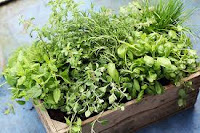By Irene Shonle, CSU Extension in Gilpin County
What is a weed? I think most of us have seen that cute little quote “A weed is just a plant whose virtues haven’t been discovered yet.” This quote aggravates me to no end because it implies that any plant that has a known virtue cannot be a weed. And that all plants in all ecosystems are fine; we just have to look for their virtues.
Most savvy gardeners and people who manage open space, rangelands, or agricultural lands know that this is not the case. There are definite bad actors that aggressively spread and cause harm to ecosystems and agricultural settings. Plants that have the previous two characteristics AND are alien plants meet the criteria for a state-listed noxious weed, and thus become illegal to grow or sell in Colorado. For more information on these weeds, please go to the Department of Agriculture website: https://www.colorado.gov/pacific/agconservation/noxious-weed-species.
 |
| Leafy spurge - a list B noxious weed in Colorado |
Not all alien plants are noxious weeds or even weeds at all. Some can be fairly aggressive (field penny cress, small yellow alyssum, dandelion) but still not rise to the level of a noxious weed. Some are merely nuisances in our landscapes (Shephard’s purse, prostrate knotweed). Many are nicely behaved garden plants (Delphiniums, Iceland poppy, tulips).
 |
| Prostrate knotweed, an alien nuisance weed |
But in our quest for novelty in our gardens, some of the alien ornamental plants we have brought in have turned out to be noxious weeds – even though they have the virtue of being pretty. And they quickly spread outside the bounds of a garden, finding niches in soil disturbed by construction, travel, recreation, etc. When they grow unchecked, they can displace native plants, reduce biological diversity and alter ecosystem processes. These impacts affect birds, pollinators and mammal populations which depend upon native plants for food, shelter, and protection from predators.
The worst ornamental invaders across all of Colorado include: purple loosestrife, ox-eye daisy, Russian olive, tamarisk, Bouncing Bet, Dame’s rocket, Dalmatian toadflax, yellow toadflax (aka butter and eggs), Mediterranean sage, common tansy, bouncing bet, scentless chamomile, and myrtle spurge.
 |
| Oxeye daisy - a list B noxious weed |
What makes the weeds so invasive?
There are five key traits that allow them to dominate natural plant communities: they have abundant fruit and seeds, effective dispersal mechanisms (either by seeds or strong, creeping roots), they are rapidly and easily established, they grow quickly, and they have aggressive, competitive behavior. Even if they are well-behaved in their country of origin, they arrive in this country without any of the mechanisms that keep plants in check, such as insects, disease, and competition.
Is it possible to plant invasive ornamentals responsibly?
Not really. As soon as the "responsible" gardener who knows about the plants invasive characteristics is out of the picture (moves away, gives away cuttings or transplants, goes on vacation), the plant has the chance of becoming a problem. Often seeds can be eaten by birds, carried by cars, dogs, or the wind and then get established in new locations, unbeknownst to the gardener. Gardeners, no matter how diligent, cannot control for natural processes, most of which rule the world of plant invasions.
 |
| Dame's rocket - a list B noxious weed, often found for sale in seed catalogs as an "old fashioned favorite." |
Become familiar with invasive species and report their presence on public lands to the agency in charge.
Choose native (natives (they will never become noxious weeds since they are not alien) or non-invasive plants for your garden, and remove any invasive ornamentals in your garden. It is usually possible to find visually similar plants to use in place of invasives. The Garden Smart guide was specifically written to help with this: https://conps.org/wp-content/uploads/2015/05/Garden_Smart_Colorado.pdf. Both the Native Plant Master Program (conativeplantmaster.org) and the Colorado Native Plant Society (www.conps.org) are wonderful resources for people wanting to use more natives in their landscaping.
Ask your local greenhouse and/or nursery to stock more natives. Report any noxious ornamentals to the Department of Agriculture (it is illegal to sell ornamental noxious weeds in Colorado – even if you get seeds by mail order.) If you do see an invasive ornamental in a seed catalog/website, you can politely and pleasantly inform the company that they need to add “not for sale in CO” to the plant.


































